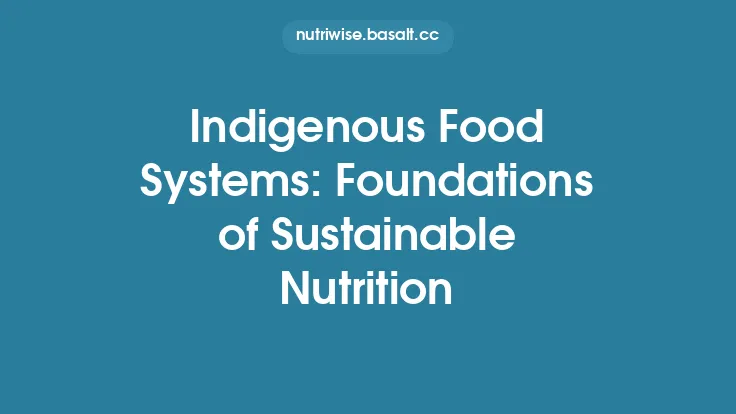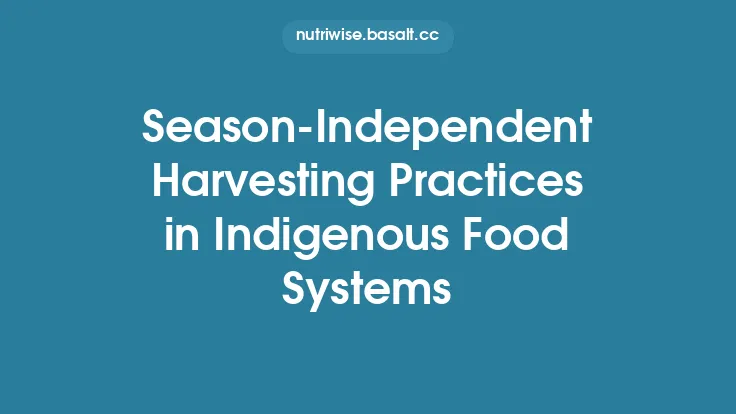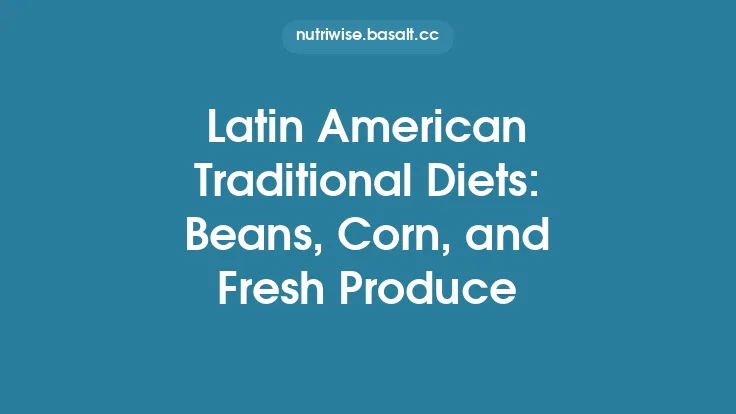The relationship between people and the plants they cultivate is one of the oldest recorded partnerships on Earth. Across continents, Indigenous communities have identified, selected, and refined a remarkable array of crops that not only sustain caloric needs but also deliver a dense package of vitamins, minerals, essential fatty acids, and bioactive compounds. These traditional crops—often overlooked in mainstream agriculture—represent a reservoir of nutritional wealth that has been honed through generations of observation, experimentation, and cultural practice. Understanding the specific nutrient profiles of these plants, the environmental conditions that favor their growth, and the processing methods that preserve their value provides insight into a food system that is both resilient and richly nourishing.
Key Nutrient-Dense Crops Across Regions
Indigenous food systems are as diverse as the ecosystems they inhabit. While the specific species differ, many share common traits: high micronutrient density, adaptability to marginal soils, and the ability to thrive under variable climatic conditions. Below is a non‑exhaustive list of crops that consistently rank among the most nutrient-dense in their respective regions:
| Region | Crop (Scientific Name) | Primary Nutrients | Notable Phytochemicals |
|---|---|---|---|
| Mesoamerica | Maize (Zea mays) – especially blue and purple landraces | Carbohydrates, lysine‑enriched protein, vitamin A (β‑carotene), magnesium | Anthocyanins, phenolic acids |
| Andes | Quinoa (Chenopodium quinoa) | Complete protein (all essential amino acids), iron, zinc, calcium, B‑vitamins | Saponins, flavonoids |
| North America (Great Plains) | Amaranth (Amaranthus spp.) – grain and leaf | Protein (high lysine), calcium, magnesium, vitamin K | Betalains, tocopherols |
| Sahel | Pearl millet (Pennisetum glaucum) | Carbohydrates, iron, zinc, B‑vitamins, unsaturated fatty acids | Phenolic acids, lignans |
| Pacific Islands | Taro (Colocasia esculenta) | Carbohydrates, potassium, vitamin C, dietary fiber | Polyphenols, resistant starch |
| Sub‑Saharan Africa | Sorghum (Sorghum bicolor) – especially sorghum varieties with red pericarp | Carbohydrates, protein, iron, B‑vitamins | Tannins, flavonoids |
| Amazon Basin | Camu camu (Myrciaria dubia) – fruit | Vitamin C (up to 3,000 mg/100 g), potassium, calcium | Anthocyanins, ellagic acid |
| Andean Highlands | Oca (Oxalis tuberosa) | Carbohydrates, vitamin C, potassium, calcium | Oxalic acid (in low concentrations) |
| Central America | Chia (Salvia hispanica) – seed | Omega‑3 fatty acids (ALA), protein, calcium, magnesium | Lignans, phenolic acids |
These crops are not merely “high‑calorie” staples; they provide a spectrum of nutrients that address both macronutrient and micronutrient requirements, often surpassing conventional Western varieties in specific metrics.
Maize (Zea mays) – A Staple of Mesoamerican Diets
Maize, domesticated over 9,000 years ago in the Balsas River valley, exhibits a remarkable genetic diversity that includes pigmented landraces rich in anthocyanins and carotenoids. The blue and purple varieties, for instance, contain up to 30 mg of anthocyanins per 100 g, compounds linked to antioxidant activity and modulation of inflammatory pathways.
Nutrient profile (per 100 g raw kernels, average landrace):
- Energy: 365 kcal
- Protein: 9.4 g (high in tryptophan, moderate lysine)
- Fat: 4.7 g (predominantly unsaturated)
- Carbohydrate: 74 g (including 7 g dietary fiber)
- Vitamin A (β‑carotene): 150 µg (≈ 17 % DV)
- Magnesium: 127 mg (≈ 30 % DV)
- Iron: 2.7 mg (≈ 15 % DV)
Traditional processing—nixtamalization (alkaline cooking in calcium hydroxide solution)—enhances calcium content (up to 200 mg/100 g) and releases bound niacin, preventing pellagra. This method also reduces phytic acid, a known inhibitor of mineral absorption, thereby improving bioavailability of iron and zinc.
Quinoa (Chenopodium quinoa) – Andean High‑Altitude Nutrition
Quinoa thrives at elevations above 2,500 m, where ultraviolet radiation and low atmospheric pressure impose stress on plant metabolism. The plant responds by synthesizing protective compounds, resulting in a seed that is both nutritionally dense and resilient.
Nutrient profile (per 100 g dry seed):
- Energy: 368 kcal
- Protein: 14.1 g (complete amino acid profile; lysine: 0.9 g)
- Fat: 6.1 g (≈ 55 % polyunsaturated, including linoleic and α‑linolenic acids)
- Carbohydrate: 64 g (including 7 g dietary fiber)
- Iron: 4.6 mg (≈ 25 % DV)
- Zinc: 3.1 mg (≈ 28 % DV)
- Calcium: 47 mg (≈ 5 % DV)
Quinoa’s saponin coating, while bitter, serves as a natural pesticide. Traditional washing and soaking remove most saponins, reducing antinutrient load without compromising the seed’s mineral content. Moreover, the high levels of flavonoids such as quercetin and kaempferol contribute to antioxidant capacity.
Amaranth (Amaranthus spp.) – Dual-Purpose Leaf and Seed
Amaranth is unique in that both its leaves and seeds are consumed, each offering distinct nutritional benefits. The leaves are a source of vitamin K, vitamin A (β‑carotene), and folate, while the seeds provide a protein profile rich in lysine and methionine.
Nutrient profile (seed, per 100 g dry weight):
- Energy: 371 kcal
- Protein: 13.6 g (lysine: 1.1 g)
- Fat: 7.0 g (≈ 60 % unsaturated)
- Carbohydrate: 65 g (including 6 g dietary fiber)
- Calcium: 159 mg (≈ 16 % DV)
- Iron: 7.6 mg (≈ 42 % DV)
The leaves, when cooked, retain up to 90 % of their vitamin C content, a notable achievement given the heat sensitivity of the vitamin. Traditional steaming or sautéing with minimal water preserves both micronutrients and the bioactive betalain pigments responsible for the plant’s deep red hue.
Millet Varieties in Sahelian Communities
Millets, particularly pearl millet (Pennisetum glaucum) and finger millet (Eleusine coracana), dominate the semi‑arid zones of the Sahel. Their C4 photosynthetic pathway confers high water‑use efficiency, allowing them to produce substantial biomass under limited rainfall.
Nutrient profile (pear millet, per 100 g dry grain):
- Energy: 378 kcal
- Protein: 11.0 g (high in methionine)
- Fat: 4.2 g (predominantly unsaturated)
- Carbohydrate: 73 g (including 8 g dietary fiber)
- Iron: 3.0 mg (≈ 17 % DV)
- Zinc: 2.0 mg (≈ 18 % DV)
- Calcium: 27 mg (≈ 3 % DV)
Finger millet is especially notable for its calcium content—up to 344 mg per 100 g—making it one of the richest plant sources of this mineral. Traditional fermentation of millet dough (e.g., “koko” or “injera”) reduces phytate levels, thereby enhancing mineral absorption.
Taro (Colocasia esculenta) in Pacific Island Cultures
Taro is a staple tuber in many Pacific Island societies, valued for its ability to grow in waterlogged soils where other crops fail. Its corms store carbohydrates primarily as resistant starch, which resists digestion in the small intestine and functions as a prebiotic fiber in the colon.
Nutrient profile (raw corm, per 100 g):
- Energy: 142 kcal
- Protein: 1.5 g
- Fat: 0.2 g
- Carbohydrate: 34 g (including 5 g dietary fiber)
- Potassium: 484 mg (≈ 10 % DV)
- Vitamin C: 23 mg (≈ 25 % DV)
Traditional preparation methods—such as steaming in banana leaves or baking in earth ovens—preserve the resistant starch fraction. Moreover, the presence of polyphenols like chlorogenic acid contributes to antioxidant activity, while the low glycemic index of cooked taro supports stable blood glucose levels.
Sorghum (Sorghum bicolor) – African Agroecosystems
Sorghum’s genetic diversity includes varieties with pigmented pericarps (red, brown, black) that are rich in phenolic compounds. These pigments not only protect the grain from UV damage but also provide health‑promoting antioxidants.
Nutrient profile (red sorghum, per 100 g dry grain):
- Energy: 329 kcal
- Protein: 11.3 g (balanced amino acid profile)
- Fat: 3.3 g (mostly unsaturated)
- Carbohydrate: 72 g (including 6 g dietary fiber)
- Iron: 3.5 mg (≈ 20 % DV)
- Magnesium: 165 mg (≈ 40 % DV)
Traditional malting of sorghum for beverages (e.g., “tela” or “kunu”) activates endogenous enzymes that break down complex carbohydrates into simpler sugars, improving digestibility and releasing bound phenolics. This process also reduces tannin content, which can otherwise impair protein digestibility.
Wild Tubers and Roots: Oca, Yacon, and More
Beyond cultivated staples, many Indigenous groups rely on wild or semi‑domesticated tubers that offer unique nutrient profiles:
- Oca (Oxalis tuberosa): High in vitamin C (up to 30 mg/100 g) and potassium; contains inulin, a soluble fiber that promotes beneficial gut microbiota.
- Yacon (Smallanthus sonchifolius): Stores fructooligosaccharides (FOS) that function as prebiotic fibers; low caloric density (≈ 20 kcal/100 g) yet high in antioxidants.
- Cassava (Manihot esculenta) – bitter varieties: After careful processing (grating, fermenting, drying), the cyanogenic glucosides are removed, leaving a carbohydrate‑rich staple with modest protein (≈ 1 g/100 g) but high energy density.
These tubers illustrate how Indigenous knowledge of processing techniques can transform potentially toxic or low‑nutrient plants into valuable dietary components.
Traditional Processing Techniques that Preserve Nutrients
Indigenous food systems employ a suite of processing methods that are both culturally embedded and nutritionally advantageous:
- Nixtamalization (alkaline cooking): Improves calcium content, releases bound niacin, and reduces phytic acid in maize.
- Fermentation: Utilized for millet, sorghum, cassava, and tubers; microbial activity degrades antinutrients, synthesizes B‑vitamins, and enhances protein digestibility.
- Soaking and Sprouting: Increases the activity of endogenous amylases and proteases, raising the availability of amino acids and reducing lectins.
- Drying and Roasting: Concentrates nutrients while preserving heat‑stable vitamins (e.g., vitamin A precursors) and creating flavor compounds that encourage consumption.
- Steaming in Leaf Wrappers: Protects heat‑sensitive nutrients (vitamin C, folate) and imparts aromatic compounds from the wrapper plant.
These techniques are not merely culinary preferences; they are integral to maximizing the nutritional yield of each crop.
Storage and Fermentation Practices Enhancing Nutrient Retention
Long‑term storage is essential in environments with seasonal food scarcity. Indigenous methods often combine physical preservation with biochemical transformation:
- Earthenware and Clay Pots: Provide a cool, stable microclimate that slows enzymatic degradation of vitamins.
- Underground Pit Storage: Used for tubers like taro and oca; the low temperature and limited oxygen reduce oxidative loss of carotenoids.
- Lactic Acid Fermentation: Converts sugars into lactic acid, lowering pH and inhibiting spoilage microbes while preserving vitamin B‑complex levels.
- Smoke‑Drying: Imparts antimicrobial phenols from wood smoke, extending shelf life of grains and seeds without significant loss of mineral content.
These practices illustrate a sophisticated understanding of food chemistry that predates modern food science.
Nutrient Synergy in Indigenous Food Assemblages
Indigenous diets rarely rely on a single crop; instead, they combine multiple foods in ways that create synergistic nutritional effects. For example:
- Maize + Beans + Squash (the “Three Sisters”): Maize provides carbohydrates, beans supply lysine‑rich protein, and squash contributes vitamin A and minerals. The combination balances amino acid profiles and supplies a broader spectrum of micronutrients.
- Quinoa + Amaranth Leaves: The leaf greens supply vitamin K and folate, complementing the protein and mineral content of the seeds.
- Millet Porridge with Fermented Dairy (e.g., kefir): Fermented dairy adds calcium and probiotic bacteria, enhancing mineral absorption from the millet.
Such assemblages reflect an empirical knowledge of complementary nutrition, achieved through centuries of observation and cultural transmission.
Implications for Contemporary Nutrition Research
The nutrient-dense crops highlighted here offer several avenues for modern scientific inquiry:
- Bioactive Compound Mapping: Detailed phytochemical profiling of pigmented landraces (e.g., blue maize, red sorghum) can identify novel antioxidants for functional food development.
- Genotype‑Environment Interactions: Studying how high‑altitude stressors influence nutrient synthesis in quinoa may inform breeding programs aimed at enhancing micronutrient content in other cereals.
- Processing Optimization: Replicating traditional fermentation and nixtamalization at scale could improve mineral bioavailability in fortified grain products.
- Prebiotic Potential: Inulin‑rich tubers like oca and FOS‑rich yacon present opportunities for developing gut‑health promoting ingredients.
By integrating Indigenous agronomic wisdom with contemporary analytical tools, researchers can expand the portfolio of nutrient-dense foods available to global populations while honoring the cultural origins of these crops.
The enduring legacy of Indigenous agricultural practices demonstrates that nutrient density is not an accidental by‑product but a deliberate outcome of careful selection, cultivation, and processing. These traditional crops continue to offer a blueprint for building food systems that are both nutritionally robust and ecologically attuned.





